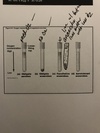Chapter 6 Flashcards
Microbial growth
Orderly and permanent increase of the mass of an individual or a population of microbes.
Reproduction
Is an increase in the numbers of individuals and can be independent of growth, although the result of reproduction is usually growth.
Growth Requirements
Nutrients, - carbon, oxygen nitrogen and hydrogen
Chemical and energy requirements
Nutrients - sources of carbon, energy and electrons
Chemical and energy requirements 2 - groups of organisms source of carbon
-Autotrophs -heterotrophs
Chemical and energy requirements 2 - groups of organisms
- chemotrophs - phototrophs
Physical requirements temperature
Effect of temperature on proteins - very high temp can cause denaturing Effect of temperature on membrane of cells and organelles -if too low, membranes become rigid and fragile -if too high, membranes become too fluid
Effects of temperature on bacterial growth
Psychrophiles: “cold lovers” grow at -5C to 20C Mesophiles: “middle-loving”, grow at 15C-45C Thermophiles: “heat-lovers”, grow at 45C-80C
Physical requirements: pH
Neutrophils - normal Range (6.5-7.5) Acidophiles - best grown in acidic habitats Alkalinophiles - live in alkaline soils and water
Acidophiles
Grow best in acidic habitats
Alkalinophiles
Live in alkaline soils and water
Isotonic solution
No bet movement of water
Hypotonic solution
War will move into the cell (cell swells up and can lyse)
Hypertonic solution
Water moves out of the cell (cell shrinks, plasmolysis)
Hydrostatic pressure Barophiles
Live under extreme pressure. Depends on pressure to maintain shape
O2 requirements Obligate Aerobe
O2 is essential
Obligate Anaerobes
O2 is deadly
Radical
Oxydation
Superoxide Radical (SOR)
Extremely toxic to living cells
Superoxide dismutase (SOD)
Enzyme that neutralizes SOR -produced by all organisms in the presence of O2. SOD coverts superoxide radical to hydrogen peroxide (H2O2) which is also toxic
2 enzymes that naturalize Hydrogen Peroxide
Catalase Peroxidase
Catalase
presence of this enzyme in an organism can be detected by applying hydrogen peroxide to a culture (on solid media) and observing presence of bubbles.
Peroxidase
no bubbles reaction doesn’t produce gaseous oxygen, no bubbling and be seen when applying hydrogen peroxide
Obligate Aerobes
require oxygen for growth



